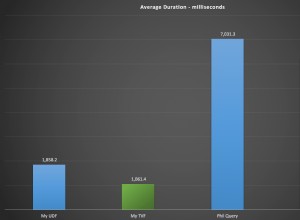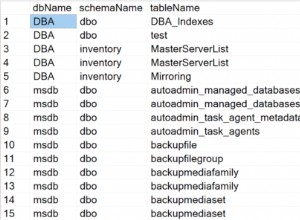Aquí hay una consulta rápida para ilustrar el comportamiento:
select
v,
-- FIRST_VALUE() and LAST_VALUE()
first_value(v) over(order by v) f1,
first_value(v) over(order by v rows between unbounded preceding and current row) f2,
first_value(v) over(order by v rows between unbounded preceding and unbounded following) f3,
last_value (v) over(order by v) l1,
last_value (v) over(order by v rows between unbounded preceding and current row) l2,
last_value (v) over(order by v rows between unbounded preceding and unbounded following) l3,
-- For completeness' sake, let's also compare the above with MAX()
max (v) over() m1,
max (v) over(order by v) m2,
max (v) over(order by v rows between unbounded preceding and current row) m3,
max (v) over(order by v rows between unbounded preceding and unbounded following) m4
from (values(1),(2),(3),(4)) t(v)
El resultado de la consulta anterior se puede ver aquí (SQLFiddle aquí ):
| V | F1 | F2 | F3 | L1 | L2 | L3 | M1 | M2 | M3 | M4 |
|---|----|----|----|----|----|----|----|----|----|----|
| 1 | 1 | 1 | 1 | 1 | 1 | 4 | 4 | 1 | 1 | 4 |
| 2 | 1 | 1 | 1 | 2 | 2 | 4 | 4 | 2 | 2 | 4 |
| 3 | 1 | 1 | 1 | 3 | 3 | 4 | 4 | 3 | 3 | 4 |
| 4 | 1 | 1 | 1 | 4 | 4 | 4 | 4 | 4 | 4 | 4 |
Pocas personas piensan en los marcos implícitos que se aplican a las funciones de ventana que toman un ORDER BY cláusula. En este caso, las ventanas tienen por defecto el marco RANGE BETWEEN UNBOUNDED PRECEDING AND CURRENT ROW . (RANGO no es exactamente lo mismo que FILAS, pero esa es otra historia). Piénsalo de esta manera:
- En la fila con
v = 1el marco de la ventana ordenada abarcav IN (1) - En la fila con
v = 2el marco de la ventana ordenada abarcav IN (1, 2) - En la fila con
v = 3el marco de la ventana ordenada abarcav IN (1, 2, 3) - En la fila con
v = 4el marco de la ventana ordenada abarcav IN (1, 2, 3, 4)
Si quieres evitar ese comportamiento, tienes dos opciones:
- Use un
ROWS BETWEEN UNBOUNDED PRECEDING AND UNBOUNDED FOLLOWINGcláusula para pedido funciones de ventana - No usar
ORDER BYcláusula en aquellas funciones de ventana que permiten omitirlas (comoMAX(v) OVER())
Se explican más detalles en este artículo sobre LEAD() , LAG() , FIRST_VALUE() y LAST_VALUE()




